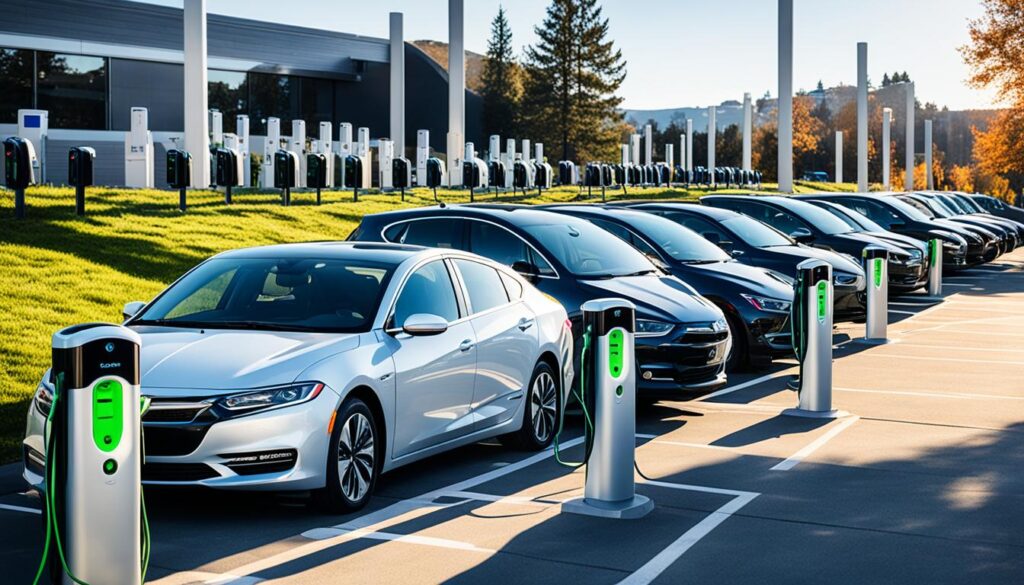The workplace charging scheme is an important initiative for organizations looking to provide electric vehicle charging at work. By implementing a workplace charging scheme, businesses can futureproof their workplace, improve employee retention and attract new talent, promote sustainability initiatives, and take advantage of financial incentives.
Key Takeaways:
- The workplace charging scheme helps organizations provide electric vehicle charging at work.
- Implementing a workplace charging scheme futureproofs the workplace.
- A workplace charging scheme improves employee retention and attracts new talent.
- Workplace EV charging promotes sustainability initiatives.
- Financial incentives are available through government grants.
Determining the Number of Charge Points Needed
When implementing a workplace charging scheme, it is crucial to determine the number of charge points required based on several factors. These factors include the number of electric cars operated by the organization, the types of chargers needed (e.g., 7kW, 22kW, etc.), the number of available parking bays, and the budget allocated for installations.
Firstly, organizations should consider the number of electric cars in their fleet. This includes both company-owned electric vehicles and vehicles driven by employees who bring their own electric cars to work. By assessing the charging needs of these individuals, organizations can ensure that sufficient charge points are installed to accommodate their requirements.
The types of chargers needed also play a significant role in determining the number of charge points. Different electric car models may have varying charging capabilities, and it is essential to provide chargers that can accommodate these specifications. This ensures that employees can charge their vehicles efficiently and effectively while at the workplace.
Another factor to consider is the number of available parking bays. Organizations need to evaluate how many parking spaces can be designated for electric vehicle charging, as each charge point requires a dedicated parking bay. By assessing the number of available parking bays, organizations can determine the maximum number of charge points that can be installed at the workplace.
Lastly, the available budget for installations is a critical consideration. Organizations need to allocate funds for the purchase and installation of charge points. By aligning the budget with the determined factors, organizations can ensure that they can implement an effective workplace charging scheme without exceeding their financial capabilities.
Forward planning and over-provisioning can also be beneficial when determining the number of charge points needed. By anticipating future growth in the electric vehicle fleet, organizations can install additional charge points to accommodate potential increases in demand over time.
Overall, a thoughtful assessment of the number of charge points needed is crucial for a successful workplace charging scheme. By considering the number of electric cars operated, the charger types required, the available parking bays, and the allocated budget, organizations can ensure that their employees have access to sufficient charging infrastructure.
Choosing the Speed of Charge Points
When implementing a workplace charging scheme, one of the key considerations is selecting the appropriate speed for the charge points. The speed of the charge points should align with the types of vehicles used by employees and the power availability at the site.
While it may be tempting to opt for faster charge points, it is important to assess whether they are necessary or cost-effective for the organization’s specific needs. Let’s take a closer look at two common options: the 7kW charge point and the 150kW charge point.
7kW Charge Point
A 7kW charge point is a popular choice for workplace charging schemes. It offers a balanced charging speed that provides up to five miles of charge in just 10 minutes. This speed is sufficient for many electric vehicles used for commuting to and from work, especially considering the average daily commute distance in the United Kingdom.
Additionally, the 7kW charge point is relatively affordable and doesn’t require extensive power availability. It can be easily installed in most workplace environments without significant upgrades to the electrical infrastructure.
150kW Charge Point
On the other end of the spectrum, the 150kW charge point offers a much higher charging speed. This type of charge point can provide up to 100 miles of charge in the same 10-minute timeframe. However, it is important to carefully evaluate the need for such high-speed charging.
The 150kW charge point is typically used for fast-charging stations along major highways or in locations where quick turnaround times are critical, such as public EV charging stations. While it may seem beneficial to have this level of charging speed at the workplace, it may not be necessary for most organizations that can provide time for EVs to charge during working hours.
To determine the appropriate speed of charge points, organizations should consider the types of vehicles used by their employees and the power availability at the site. It is crucial to strike a balance between power requirements and the dwell time of electric vehicles at the workplace.
By making an informed decision about the speed of charge points, businesses can optimize their workplace charging scheme and create a seamless charging experience for their employees. Next, let’s explore the importance of strategic charge point location within the workplace.
Location of Charge Points
In a workplace charging scheme, the location of charge points is a crucial factor to consider. Typically, charge points are strategically placed near the main building and adjacent to the electricity supply for convenience. Having charge points in close proximity to the entrance of the workplace can be seen as a perk for employees, giving them easy access to charging facilities.
However, it is important to ensure clear signage indicating that these charging bays are exclusively for electric vehicle charging. This helps prevent misuse by non-electric vehicles and ensures that the charging spots are reserved for those who need them.
Another important aspect to consider is the physical positioning of the charge points. Electric cars usually have their charging ports located on or near the front of the vehicle. Therefore, it is advisable to position the charge points in a way that aligns with the location of the charging ports, making it easier for users to connect their vehicles.

Eye-level signage and ground markings can also be utilized to clearly indicate that the parking spaces are specifically designated for electric vehicle charging. By implementing these visual cues, workplaces can create a user-friendly environment and help ensure smooth operations of the charging infrastructure.
Installation on Leased Sites
Installing charge points on leased sites requires permission from the landlord. However, many lease agreements have clauses regarding improvements to the building, which can include the installation of charge points. It is important for organizations to discuss the installation with their landlord and highlight the benefits of workplace charging. By framing the installation as an improvement to the building, businesses may be able to gain permission to install charge points on leased sites.
When it comes to implementing a workplace charging scheme, leased sites can present unique challenges. However, with the right approach, organizations can navigate these obstacles and ensure access to charging infrastructure.
It is essential first to review the lease agreement and identify any clauses related to building improvements. Many leases include provisions that allow for modifications or enhancements to the property. These improvements can range from structural changes to electrical upgrades.
When discussing the installation with the landlord, emphasize the benefits that workplace charging can bring to the property. Highlight the positive impact on sustainability efforts, the potential to attract and retain environmentally conscious tenants, and the forward-thinking image associated with providing electric vehicle charging infrastructure.
“By integrating charge points into the building, we will not only meet the growing demand for electric vehicle charging but also enhance the property’s appeal to eco-conscious businesses. This installation aligns with our commitment to sustainability and positions the building as a forward-thinking workplace.”
Engage in open and transparent communication with the landlord, addressing any concerns they may have about the installation process. Discuss the steps that will be taken to ensure a seamless installation, such as working with licensed electricians and adhering to all safety regulations.
By framing the charge point installation as an improvement to the building, organizations can increase their chances of obtaining permission from the landlord for leased sites. This strategic approach allows businesses to embrace workplace charging and contribute to the electric vehicle infrastructure while reaping the benefits of a forward-thinking and sustainable workplace.
Government Support for Workplace Charging
The government plays a crucial role in supporting the adoption of electric vehicles through the Workplace Charging Scheme (WCS). This scheme offers financial assistance to businesses looking to implement a workplace charging scheme. By providing grants towards the upfront costs of purchasing and installing charge points at the workplace, the government aims to make workplace charging more accessible and affordable.
Through the WCS, businesses can receive grants that cover up to 75% of the cost per socket, with a maximum limit of 40 sockets per company. This financial assistance helps organizations offset the expenses associated with implementing a workplace charging scheme, making it more financially viable and attractive.
By taking advantage of the government’s support, businesses can accelerate the transition to electric vehicles and contribute to a cleaner and more sustainable future. The grants provided through the Workplace Charging Scheme not only reduce the financial burden of installing charge points but also encourage organizations to embrace workplace charging and promote the wider adoption of electric vehicles.
Furthermore, the Workplace Charging Scheme demonstrates the government’s commitment to supporting sustainable transportation initiatives and reducing carbon emissions. By incentivizing and supporting workplace charging, the government recognizes the crucial role that businesses play in driving the adoption of electric vehicles and creating a greener transportation landscape.
Financial Assistance through the Workplace Charging Scheme
To facilitate the implementation of workplace charging schemes, the government offers financial assistance through the Workplace Charging Scheme. This financial support helps businesses cover a significant portion of the costs involved in purchasing and installing charge points at the workplace.
The financial assistance provided by the government can be instrumental in supporting organizations, especially smaller businesses, that may have limited budgets for implementing workplace charging schemes. By reducing the upfront costs, the grants offered through the Workplace Charging Scheme make workplace charging more accessible and affordable for businesses of all sizes.
Businesses can use the financial assistance to invest in high-quality charge points, which ensure efficient and reliable charging for employees’ electric vehicles. Additionally, the grants can help cover the costs of electrical infrastructure upgrades, installation, signage, and any necessary maintenance or repairs.
By leveraging the financial assistance available through the Workplace Charging Scheme, businesses can take proactive steps towards transitioning to electric vehicles, contributing to a cleaner environment, and embracing sustainable transportation solutions.
Charging Costs and Incentives
When implementing a workplace charging scheme, it is essential to consider the charging costs and incentives for employees. There are various approaches to managing these costs, depending on the organization’s goals and resources.
Many companies currently provide free charging to employees as a perk, recognizing the importance of supporting electric vehicle adoption and encouraging sustainable commuting choices. Offering free charging can be a powerful incentive, making it easier for employees to choose electric vehicles without worrying about the additional cost of charging at work.
Alternatively, some organizations may choose to implement a fee for usage based on the amount of electricity used or the length of time the vehicle is plugged in. This approach helps manage charge point usage, ensuring fair access for all employees, while also incentivizing drivers to unplug their vehicles when they have enough charge. Charging fees can be calculated using billing methods to accurately track electricity consumption and ensure transparency.
Moreover, employees who use workplace charge points for business mileage can typically claim reimbursement. The government sets an advisory electricity rate for reimbursement, which covers the electricity cost incurred by employees while charging their vehicles during work-related journeys.
Example Charging Fees and Rates:
| Charging Fee Structure | Charging Rate | Usage |
|---|---|---|
| No charging fees | Free | Encourages EV adoption, supports sustainability initiatives |
| Flat fee per session | $5 per charging session | Ensures fair access, covers maintenance costs |
| Usage-based fee | $0.20 per kilowatt-hour | Accurately reflects electricity consumption, encourages efficient charging |
By implementing a fair and transparent charging cost structure and offering reimbursement for business mileage, organizations can effectively manage the financial aspects of their workplace charging scheme, promoting sustainable transportation while minimizing employee expenses.
“Providing free workplace charging promotes a positive company culture centered around sustainability and environmental consciousness.” – Jane Smith, HR Manager at ABC Company

Managing the Use of Charge Points
In a workplace charging scheme, it is crucial for organizations to have an effective system for managing the use of charge points. There are various options available, depending on the resources and preferences of the company.
Internal Resources: Some organizations may choose to handle charge point management internally, utilizing their own resources for maintenance, support, and user management. This approach allows for greater control over the charging infrastructure and can be cost-effective in the long run.
Charge Point Operator: Alternatively, companies can partner with a charge point operator to handle the day-to-day management of the charge points. A charge point operator brings expertise in managing charging networks, ensuring efficient operations, and providing technical support to users. This option can offload the administrative burden from the company and allow for a more streamlined charging experience.
Access to the charge points can be managed through various methods, such as:
- RFID Cards: Providing employees with RFID cards that grant them access to the charge points. This system ensures that only authorized personnel can use the charging facilities.
- Apps: Utilizing dedicated mobile applications that allow users to locate available charge points, reserve them, and manage their charging sessions. This option provides convenience and flexibility for users.
- Contactless Payment: Enabling contactless payment methods, such as credit cards or mobile wallets, for quick and easy charging sessions. This eliminates the need for a separate payment infrastructure and simplifies the user experience.
Back-office systems can further enhance charge point management by allowing for differentiated payment schemes based on user groups. For example, companies can choose to charge visitors for using the charging facilities while not charging their own employees, or vice versa. This flexibility can be beneficial in managing costs and ensuring fair usage of the charging infrastructure.
Benefits of Effective Charge Point Management
“Efficient charge point management ensures that employees have access to reliable and available charging facilities, enhancing their experience and satisfaction with the workplace charging scheme.”
By implementing robust charge point management, organizations can avoid downtime and address any technical issues promptly. This minimizes disruptions and ensures that employees have access to reliable and available charging facilities, enhancing their experience and satisfaction with the workplace charging scheme.
Effective management also contributes to resource optimization, as it enables companies to monitor and control the usage of charge points. By analyzing usage patterns and demand, organizations can make informed decisions about expanding or optimizing their charging infrastructure.
| Benefits of Effective Charge Point Management | Description |
|---|---|
| Enhanced User Experience | Ensure reliable and available charging facilities for employees |
| Optimized Resource Allocation | Monitor and control usage, make informed decisions about infrastructure |
With efficient charge point management, organizations can maximize the benefits of their workplace charging scheme and provide a seamless experience for employees and visitors alike.
Benefits of Workplace EV Charging
Workplace EV charging offers a range of benefits for businesses. By implementing a workplace charging scheme, organizations can futureproof their workplace, improve employee retention, attract new talent, and promote sustainability initiatives. Let’s explore these benefits in detail:
1. Futureproofing
Embracing the growing trend towards electric vehicles demonstrates that the organization is innovative and socially responsible. By providing workplace charging infrastructure, businesses can stay ahead of the curve and adapt to the changing landscape of transportation.
2. Employee Retention and Convenience
Installing workplace EV charging points can significantly reduce expenses for employees who own electric vehicles. Employees no longer need to rely solely on public charging stations or charging at home, saving them time and money. This convenience can contribute to higher employee satisfaction and improve staff retention rates.
3. Attracting New Talent
Workplace EV charging schemes can be an attractive perk for potential employees, especially for those who prioritize sustainability and environmentally friendly practices. By offering EV charging options, organizations can differentiate themselves from competitors and attract top talent looking for eco-conscious workplaces.
4. Sustainability Initiatives
Implementing workplace EV charging infrastructure aligns with sustainability goals and demonstrates the organization’s commitment to reducing carbon emissions. By providing employees with the means to charge their electric vehicles at work, businesses actively contribute to a greener environment and can showcase their corporate social responsibility.
5. Financial Incentives
Government grants and financial incentives are available through the workplace charging scheme. These grants can help offset the costs of installing EV charging infrastructure. Additionally, organizations can achieve cost savings through on-site charging, reducing the reliance on expensive fuel and maintenance for traditional vehicles in their fleets.
By embracing workplace EV charging, businesses can create a more sustainable and forward-thinking workplace while reaping the benefits of employee satisfaction, talent attraction, and cost savings. The future of transportation is electric, and organizations that invest in workplace charging schemes will position themselves as leaders in the evolving landscape of sustainable mobility.
Conclusion
The workplace charging scheme provides numerous benefits for organizations, making it a smart investment for businesses looking to stay ahead. By implementing workplace EV charging infrastructure, companies can futureproof their workplace, improve employee retention, attract new talent, and promote sustainability initiatives.
One of the key advantages of the workplace charging scheme is the government support available through the Workplace Charging Scheme. This support includes grants that offset the costs of installing workplace EV charging infrastructure, making it more affordable for businesses to adopt this sustainable solution.
By embracing workplace charging, businesses can enhance their reputation as forward-thinking and socially responsible organizations. They contribute to the transition to electric vehicles and help create a more sustainable future. Additionally, the financial incentives provided by the government grants and cost savings from on-site charging can result in significant long-term benefits for businesses.
With the workplace charging scheme, organizations have the opportunity to make a positive impact on their employees, the environment, and their bottom line. It’s a win-win situation that supports both the future of mobility and the success of businesses across the United Kingdom.











order priligy Posted on Aug 23, 2007 10 42AM